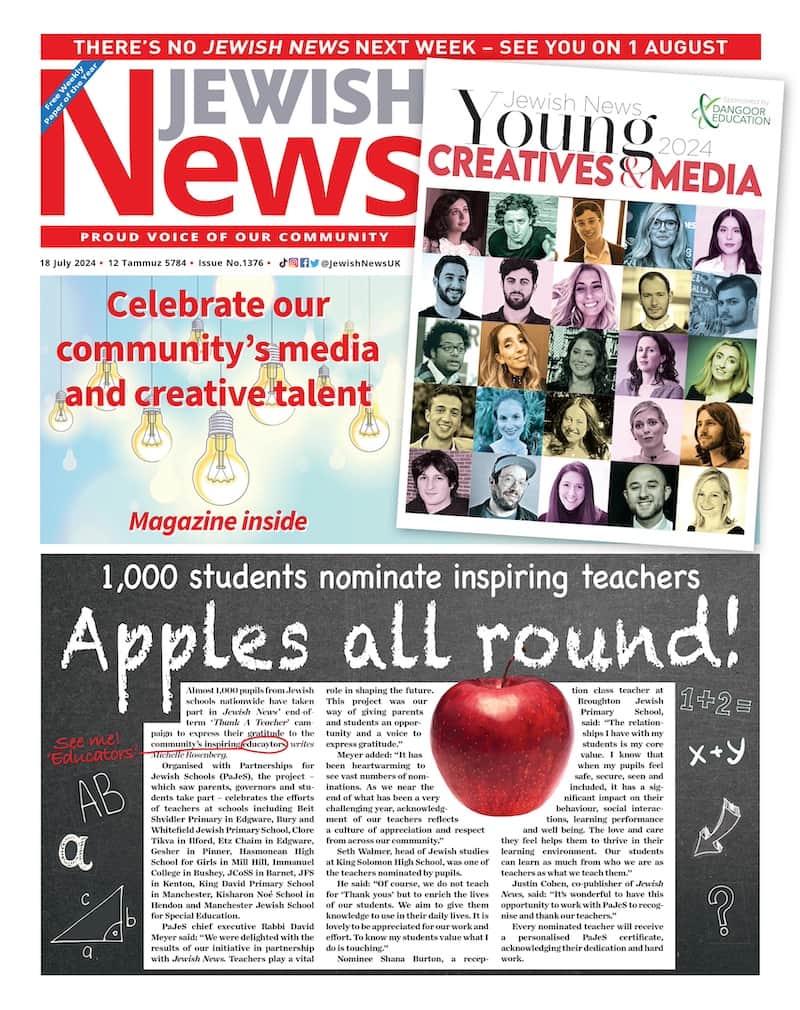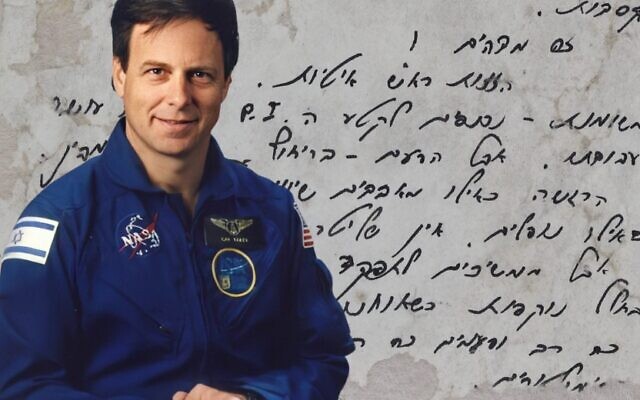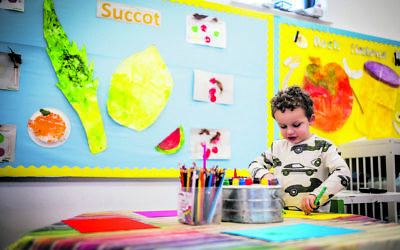Space diary of Israel’s first astronaut loaned to National Library
British-born forensic analyst worked on restoration of Ilan Ramon's diary after fatal Columbia shuttle crash in 2003.
Jenni Frazer is a freelance journalist
The London-born forensic analyst who worked on the preservation of the space diary of Ilan Ramon, the first Israeli astronaut, has spoken of her “sadness and pride” at working on the material, as it was announced that the Ramon diary was going on long-term loan to the National Library of Israel.
Sharon Landau Brown was working in the laboratories of the Israel Police, when the Israeli Air Force were notified that the diary — then still a random collection of papers — had been found in a field in Texas.
That was just over two months after the February 2003 fatal crash of Space Shuttle Columbia, which disintegrated as it re-entered earth’s atmosphere, killing all seven astronauts on board. Columbia had successfully completed 27 missions before the disaster, and Ramon’s mission had been routine, with the crew performing 80 science and physics experiments before beginning their return to Earth’s surface.

The National Library of Israel said: “Like all astronauts before him, Ramon took personal items with him to space. But his had special national significance as well: a tiny Torah scroll rescued from the Bergen-Belsen concentration camp; a copy of a drawing by Petr Ginz, a boy murdered at Auschwitz, entitled, ‘Moon Landscape’, and some wine for blessing on Shabbat. There was also a letter from his son Assaf (later a fighter pilot who was tragically killed in a flight training accident in 2009), as well as a notebook for documenting his personal experience”.

Ramon had apparently written at least one page before takeoff, but wrote the rest of the pages while in space. Some entries are prosaic – describing brushing his teeth in low-gravity, conducting scientific experiments, and expressing longing for his family – but there are also casual mentions of conversations with the Prime Minister of Israel and the president of the United States.
“…Columbia, Houston, we see your tyre pressure messages and we did not copy your last,” was the last complete transmission between Columbia and the control centre in Houston, before the craft broke apart over Texas and Louisiana.
After its discovery, the diary was transferred to the Israel Museum for the complex process of restoration and preservation, assisted by the Israel Police’s forensic department.

After 20 years at the Israel Museum, the diary has now arrived at the National Library of Israel. The transfer was carried out by NLI staff, accompanied by Ramon’s surviving sons, Tal and Yiftach. After initial processing, the diary was scanned by the Library’s digital department, and is now stored in a vault within the Library’s rare items repository, where humidity and temperature conditions are continuously monitored and controlled to protect the treasures within.

Sharon Landau Brown, who was on a plane to Israel two weeks after finishing her A levels at Hasmonean High School, began working on the diary in July of 2003 and spent six months on the task. The event has special significance for her: her mother was diagnosed with terminal cancer two days after the diary was found in Texas. And her name was Colomba, from the same root as the name of the tragic spacecraft, both meaning “dove”.
“I wasn’t so senior in the laboratory at the time”, she says, “but I was picked to work on the diary because my mother was sick and I was one of the few people not going away for the summer”. In her last week of conscious life, “my mother told me what a huge privilege it was for this to be my case. So everything was pride, and hope and sadness, with such meaning”.

When the diary arrived at the police laboratory, handed over by the Israeli Air Force, “we received, basically, a pile of papers. They contained different sections of Ilan Ramon’s crew notebook. One was his personal diary, about eight pages long. Another set of pages was totally washed out, and until today you can’t see anything”. These pages were treated in the laboratory with special filters “to view things that the human eye can’t see. We found that these were six pages of technical notes that he wrote before the mission: things like how to open a parachute, what medicine you can take in space if you have a headache”.

Then there were a further six pages which also looked blank, but the filter treatment previously used did not work. Instead, using the then new software of Photoshop, a photographer called Lazar Sin-David found Ilan Ramon’s list of “things he wanted to talk about from space. He wanted to be the first Jew in space to say kiddush on Friday night, so he wrote out all the words of the kiddush. He wanted to say a dvar Torah, and he drew a parallel between the things he had taken with him relating to the Holocaust, the Jewish people’s darkest hour, and the modern state of Israel and its technological advances — including going into space”.
Tragic as the crash was, Sharon Landau Brown has a great affinity for Ilan Ramon. “He got to live his dream — as did all the astronauts”, she says.

Thank you for helping to make Jewish News the leading source of news and opinion for the UK Jewish community. Today we're asking for your invaluable help to continue putting our community first in everything we do.
For as little as £5 a month you can help sustain the vital work we do in celebrating and standing up for Jewish life in Britain.
Jewish News holds our community together and keeps us connected. Like a synagogue, it’s where people turn to feel part of something bigger. It also proudly shows the rest of Britain the vibrancy and rich culture of modern Jewish life.
You can make a quick and easy one-off or monthly contribution of £5, £10, £20 or any other sum you’re comfortable with.
100% of your donation will help us continue celebrating our community, in all its dynamic diversity...
Engaging
Being a community platform means so much more than producing a newspaper and website. One of our proudest roles is media partnering with our invaluable charities to amplify the outstanding work they do to help us all.
Celebrating
There’s no shortage of oys in the world but Jewish News takes every opportunity to celebrate the joys too, through projects like Night of Heroes, 40 Under 40 and other compelling countdowns that make the community kvell with pride.
Pioneering
In the first collaboration between media outlets from different faiths, Jewish News worked with British Muslim TV and Church Times to produce a list of young activists leading the way on interfaith understanding.
Campaigning
Royal Mail issued a stamp honouring Holocaust hero Sir Nicholas Winton after a Jewish News campaign attracted more than 100,000 backers. Jewish Newsalso produces special editions of the paper highlighting pressing issues including mental health and Holocaust remembrance.
Easy access
In an age when news is readily accessible, Jewish News provides high-quality content free online and offline, removing any financial barriers to connecting people.
Voice of our community to wider society
The Jewish News team regularly appears on TV, radio and on the pages of the national press to comment on stories about the Jewish community. Easy access to the paper on the streets of London also means Jewish News provides an invaluable window into the community for the country at large.
We hope you agree all this is worth preserving.






















